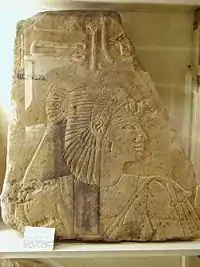Sitamun
Sitamun, also Sitamen, Satamun; Ancient Egyptian: sꜣ.t-imn, "daughter of Amun"[2] (c. 1370 BCE–unknown) was an ancient Egyptian princess and queen consort during the 18th Dynasty.
| Sitamun | ||||||
|---|---|---|---|---|---|---|
| King's Daughter Great Royal Wife | ||||||
 A relief from Amenhotep II's mortuary temple[1] adapted for Sitamun, on display at the Petrie Museum, London (UC 14373). | ||||||
| Spouse | Amenhotep III | |||||
| Egyptian name | ||||||
| Dynasty | 18th of Egypt | |||||
| Father | Amenhotep III | |||||
| Mother | Tiye | |||||
| Religion | Ancient Egyptian religion | |||||
Family
Sitamun is considered to be the eldest daughter of Pharaoh Amenhotep III and his Great Royal Wife Tiye. She was later married to her father around Year 30 of Amenhotep III's reign.[3]
The belief that Sitamun was a daughter of Amenhotep and Tiye is based on the presence of objects found in the tomb of Yuya and Thuya, Queen Tiye's parents,[4] especially a chair bearing her title as the king's daughter.
Biography
Sitamun is very well attested, most notably in the tomb of Yuya and Thuya where three finely made chairs were discovered. As these chairs were used, and are of progressively larger size, it is assumed they belonged to Sitamun as she was growing up. They were then placed in her grandparents' tomb in the tradition of placing objects which had meaning in the deceased person's life. She is also depicted on the stele of her nurse Nebetkabeny.[5]
Almost nothing is known of her life beyond being the oldest daughter of a powerful (and long-lived) queen. In the last decade of her father's reign, she was promoted to the status of Great Royal Wife. The evidence for this marriage consists of a blue-faience kohl-tube with the cartouches of Amenhotep III and Sitamun, an alabaster bowl found at Amarna with the same cartouches and jar-label inscriptions from Malkata palace. Sitamun's elevation to her role as Great Royal Wife of her father, Amenhotep III, is attested as early as Year 30 of his reign from jar label inscription No.95 which was discovered in the royal palace.[6]

She maintained her own rooms in the Malkata palace complex, and Amenhotep, son of Hapu was appointed as the steward of her properties here. She is attested on a Karnak statue of Amenhotep, son of Hapu (now in the Egyptian Museum, Cairo) where she is mentioned as the king's Great Royal Wife. She also appears on a relief from Amenhotep III's mortuary temple, found by William Matthew Flinders Petrie, (now in the Petrie Museum).[7] Sitamun is among a handful of figures that appear near the end of the reign of Amenhotep III. This was an era of Egyptian history in which women assumed far more prominent and powerful roles with Amenhotep III's wife Tiye, Sitamun's mother, being a particular example. Prior to Tiye's reign, "no previous queen ever figured so prominently in her husband's lifetime".[8] Tiye regularly appeared besides Amenhotep III in statuary, tomb and temple reliefs and stelae, while her name is paired with his on numerous small objects, such as vessels and jewellery, as well as their large commemorative scarabs.[9]
As the eldest daughter of a powerful queen, Sitamun would have been groomed for a political role but never fulfilled this potential, despite having her own property at Malkata and her high position at court. One possibility is that she was married to an heir who never assumed the throne. Another possibility is that she died prematurely or went into seclusion after her brother Akhenaten became king. She was an aunt of Tutankhamun.
She vanishes at the end of Amenhotep III's reign and is not mentioned during Akhenaten's reign. A separate chamber was carved for her in Amenhotep III's tomb in the Valley of the Kings, but there is no evidence that she was ever buried there.
Titles
- Singer of the Lord of the Two Lands
- King’s Wife
- King’s Great Wife
- King’s Daughter
- King’s Daughter Whom He Loves
- Eldest Daughter of the King
- Great Daughter of the King Whom He Loves
References
- Patrick Farsen, Die verstärkten Beziehungen zwischen Ägypten und der Ägäis unter Amenophis III, GRIN Verlag, 2010, p 4 Google Books
- Ranke, Hermann (1935). Die Ägyptischen Personennamen, Bd. 1: Verzeichnis der Namen (PDF). Glückstadt: J.J. Augustin. p. 286. Retrieved 16 August 2020.
- O'Connor, David & Cline, Eric. Amenhotep III: Perspectives on His Reign, University of Michigan Press, 1998, p.7
- Aidan Dodson & Dyan Hilton, The Complete Royal Families of Ancient Egypt, Thames & Hudson (2004), pp.146
- Dodson & Hilton, p.157.
- O'Connor & Cline, p.7
- W.M. Flinders Petrie: Six Temples at Thebes 1896, London 1897, pl. VI.8
- O'Connor & Cline, p.6
- Arielle Kozloff and Betsy Bryan, Royal and Divine Statuary in Egypt’s Dazzling Sun: Amenhotep III and his World, (Cleveland, 1992) nos. 1, 2, 12, 22, 27, 29, 56, 60, 100 & 129
Significant books on Sitamun:
- H. Schäfer's "Amarna in Religion und Kunst", Leipzig 1931.
- E. Riefstahl "Thebes in the Time of Amenhotep III", NY 1964.